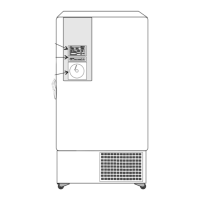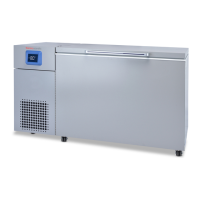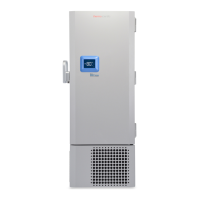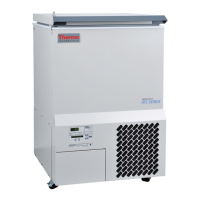
Do you have a question about the Thermo Scientific Isotemp IUE 86L Series and is the answer not in the manual?
| Brand | Thermo Scientific |
|---|---|
| Model | Isotemp IUE 86L Series |
| Category | Freezer |
| Language | English |
Explains warning symbols, caution symbols, and other indicators used in the manual.
Outlines crucial safety rules for unit operation, modification, grounding, and power.
Recommends using a redundant temperature monitoring system for continuous performance tracking.
Details the intended operating environment and warns against using it as a rapid-freeze device.
Provides instructions on how to load the freezer for the first time after reaching the desired temperature.
Explains the procedure for opening and closing the grille door.
Specifies conditions like altitude, humidity, and voltage fluctuations for optimal operation.
Lists electrical specifications including voltage, frequency, and current for different models.
Details requirements for unit placement, including space, leveling, and avoiding heat sources.
Provides crucial cautions for connecting the unit to the correct power source and grounding.
Explains the importance of a level floor and how to use leveling legs or casters.
Directs users to specific instructions for installing and operating optional backup systems.
Mentions the vacuum insulation core encapsulated by sealed film laminate in the cabinet walls.
Describes the features of the upright freezer door assembly for ultra-low temperature units.
Explains how to connect the remote alarm contacts located on the back of the freezer.
Describes the function and location of the port that relieves vacuum after door openings.
Step-by-step instructions to power on and begin operating the freezer.
Explains the basic actions required after initial startup and mentions key settings.
Shows the default display screen and explains its components and basic information.
Details the control panel buttons and the types of settings available, including alarms and setpoints.
Explains how to modify the main temperature control setpoint using the interface.
Covers accessing and adjusting other settings like alarm limits and backup system parameters.
Describes the procedure to test the warm alarm functionality of the unit.
Explains how to set and use a security code to protect setpoint changes.
Warns about the safe handling of CO2 and LN2 cylinders and gases.
Provides steps for installing the flexible hoses to connect the freezer to the backup gas supply.
Describes the operational aspects of the backup system, including power usage and rates.
Outlines the steps to start and configure the backup system after unit startup.
Details how to test the backup system to ensure proper functionality.
Explains how to prepare the chart recorder for proper function, including paper installation.
Details the steps required to replace the chart paper in the recorder.
Describes how to calibrate the recorder if adjustments are needed after power interruptions.
Provides instructions for defrosting the freezer, recommended annually or when ice buildup is significant.
Explains how to clean the condenser, recommending at least every six months.
Details how to clean the condenser filters, suggesting every two to three months.
Advises on checking and cleaning door gaskets for punctures, tears, and frost buildup.
Explains how to maintain the battery, including checking connections and recommended annual replacement.
Summarizes regular maintenance tasks and their recommended intervals for optimal unit performance.
Addresses issues like unit warming, not reaching setpoint, or slow recovery, listing causes and solutions.
Explains troubleshooting steps for display issues, breaker trips, and power failures.
Covers troubleshooting for circuit breaker trips, excessive frost build-up, and related causes.
Details problems related to overcooling, continuous compressor operation, and gasket damage.
Addresses issues where alarms are not activated or setpoints may have changed unexpectedly.
Covers temperature calibration discrepancies, constant alarming, and door latch issues.
Addresses difficulties closing doors, inner door latch problems, and various noise issues.
Describes warm and cold alarm conditions, their causes, and associated icons/events.
Explains the door open alarm, its duration trigger, and related icons/events.
Details failure alarms for control, heat exchange, and ambient probes, including error codes.
Describes communication errors between main unit/UI and backup system, including error codes.
Covers alarms for failure to reach setpoint and power failure mode, including error codes.
Explains alarms related to wrong model selection and firmware build incompatibilities.
Details alarms for system and BUS battery disconnection or failure, including error codes.
Describes the alarm triggered when a button is pressed for an extended period, including error code.











